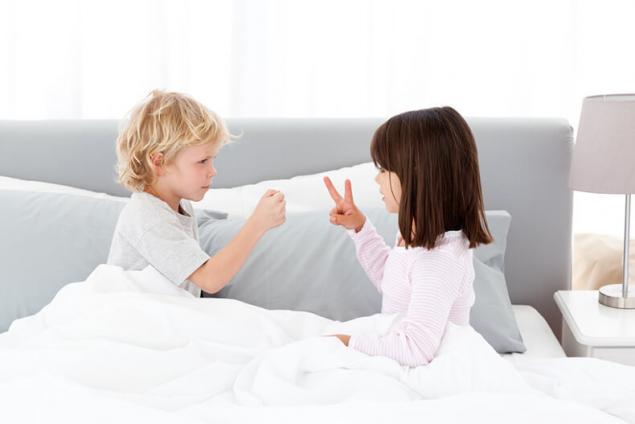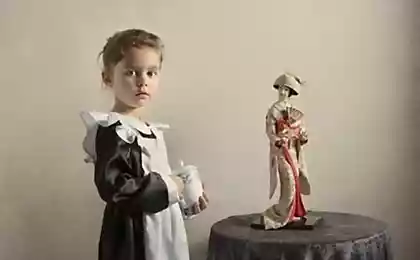590
Two men in a fight, not counting parents: Approaches to resolving children's conflicts
The other day I was asked: how to teach a child to react if he is beaten. To fight back, to complain to an adult? What to do? To the near-term and far? This question is very typical today, alas, alarming parents. They want right now, right away, to teach the child everything should and will be able to protect him from harm and danger throughout later life. Once and for all!

There is no universal recipe
Realizing this desire, I want to warn: to protect your child specific instructions in what to do, and even for the future – "always Bay; never hit; always complain about the bully; you never tattle", and any specific instructions on all occasions, in any area of social relations, it is impossible. But adults can and should teach children the basic rules of relationships – to oneself and others in a world where we all are connected.
The first such rule is treated as a sovereign individual, has an unconditional right to safety and protection. Simply put, the child should know that hitting people is impossible, neither he, nor the other – it. In practice, this rule means two things:
The principle of non-interference?
Comfortable for many adults position "in children's conflicts to intervene need not themselves understand" — it is mythology. To learn to understand, like everything else in communication, children can only the examples of attitudes and behaviors of adults. To intervene in their conflict – this means to teach them.
Is it possible to allow the child to fight back? At a certain age it is possible and even necessary. At least at a certain age (4-5 years) should not be child for such scolding. Of course, an example of behavior in a conflict situation should be the desire to negotiate, learn to solve conflicts with words. This must be taught. But a small child, when he is attacked in the first place needs to be confident in its right to self-defense. And don't be afraid to punch back.

To suppress aggression, especially at an early age, even dangerous. Of course, adults teach children to recognize and Express safe for the environment way. But any training takes time and a certain maturity. Yet, quite babies, not to prohibit strike in response to the blow. But the child should be taught "not to disperse", not to lash out at the offender in a fit of "completely destroy" him. "Enough is enough, do not diverge, he understood everything" is a necessary reaction to how your child decided to defend their rights with their fists. And here you need to show an example of how to further solve the conflict on a contractual basis.
It's a girl!
Separate questions on this topic, there are always the parents of the girls. With them-then what? They can fight? How not to turn them into "tattle tail" how to avoid the danger that they will manipulate its "devoutest", a weakness?
Girls as full "subjects" have all the same rights and duties as boys. Yes, they too have the right to shove and slap the offender and also have no right first to show physical aggression.
Girls, like boys, must be sure to protect them – parents, adults, and older children. But I would recommend still to teach girls to realize their natural privilege – the ability to reconcile, to comfort, to act out of kindness and pity.
7 mistakes of parents that prevent children become leaders
The dependence on forgiveness: don't ship children with guilt!
Girl after pushing mutual blows, ready – truly, force is not necessary, but it should be done, isto approach the offender, to say: "I feel sorry when you cry. Let's put up" and stretching "a toy of discord" are punished the bully, will have some additional, very necessary, ability to solve conflicts. And in the future, to warn them. And, maybe, this should teach the boys? published
Author: Lilya Dubinskaya
Source: womo.ua/dat-sdachi-ili-net-mnenie-psihologa-lili-dubinskoy-o-detskih-konfliktah/

There is no universal recipe
Realizing this desire, I want to warn: to protect your child specific instructions in what to do, and even for the future – "always Bay; never hit; always complain about the bully; you never tattle", and any specific instructions on all occasions, in any area of social relations, it is impossible. But adults can and should teach children the basic rules of relationships – to oneself and others in a world where we all are connected.
The first such rule is treated as a sovereign individual, has an unconditional right to safety and protection. Simply put, the child should know that hitting people is impossible, neither he, nor the other – it. In practice, this rule means two things:
- child first is allowed to show physical aggression. "You can't beat the boy!" — Mother says, ottaskivaya his cuff trying to fight for justice toddler from sustraco, whatevero him from the hands of the machine;
- the child must firmly know that it has the right to protection from any infringement on their liberty and property, and is fundamentally important! – that the parent will protect him. "This machine is Deniskina, give him back", should be an indispensable extension of the described conflict.
The principle of non-interference?
Comfortable for many adults position "in children's conflicts to intervene need not themselves understand" — it is mythology. To learn to understand, like everything else in communication, children can only the examples of attitudes and behaviors of adults. To intervene in their conflict – this means to teach them.
Is it possible to allow the child to fight back? At a certain age it is possible and even necessary. At least at a certain age (4-5 years) should not be child for such scolding. Of course, an example of behavior in a conflict situation should be the desire to negotiate, learn to solve conflicts with words. This must be taught. But a small child, when he is attacked in the first place needs to be confident in its right to self-defense. And don't be afraid to punch back.

To suppress aggression, especially at an early age, even dangerous. Of course, adults teach children to recognize and Express safe for the environment way. But any training takes time and a certain maturity. Yet, quite babies, not to prohibit strike in response to the blow. But the child should be taught "not to disperse", not to lash out at the offender in a fit of "completely destroy" him. "Enough is enough, do not diverge, he understood everything" is a necessary reaction to how your child decided to defend their rights with their fists. And here you need to show an example of how to further solve the conflict on a contractual basis.
It's a girl!
Separate questions on this topic, there are always the parents of the girls. With them-then what? They can fight? How not to turn them into "tattle tail" how to avoid the danger that they will manipulate its "devoutest", a weakness?
Girls as full "subjects" have all the same rights and duties as boys. Yes, they too have the right to shove and slap the offender and also have no right first to show physical aggression.
Girls, like boys, must be sure to protect them – parents, adults, and older children. But I would recommend still to teach girls to realize their natural privilege – the ability to reconcile, to comfort, to act out of kindness and pity.
7 mistakes of parents that prevent children become leaders
The dependence on forgiveness: don't ship children with guilt!
Girl after pushing mutual blows, ready – truly, force is not necessary, but it should be done, isto approach the offender, to say: "I feel sorry when you cry. Let's put up" and stretching "a toy of discord" are punished the bully, will have some additional, very necessary, ability to solve conflicts. And in the future, to warn them. And, maybe, this should teach the boys? published
Author: Lilya Dubinskaya
Source: womo.ua/dat-sdachi-ili-net-mnenie-psihologa-lili-dubinskoy-o-detskih-konfliktah/
The formula is correct smoothie + delicious recipe
How to whiten delicate and Lacy white stuff: 5 effective ways























